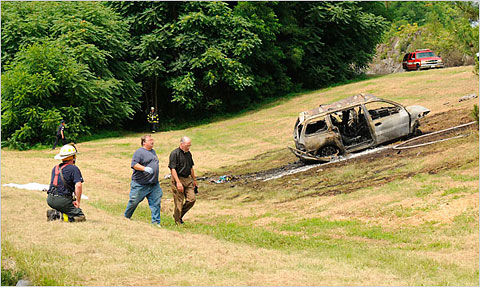Two years after a horrific wrong-way crash on the Taconic Parkway made national headlines when eight people were killed, a new lawsuit was filed that looks to examine if the State of New York shares blame.
Toxicology reports after the crash had showed minivan driver Diane Schuler was drunk and high when going the wrong way on the Taconic while loaded down with kids, only to slam head-on into an SUV carrying Michael Bastardi Sr., Guy Bastardi and Daniel Longo of Yonkers. All three were killed. Ms. Schuler of Long Island was also killed, as were one of her own children and three nieces in her minivan. The sole survivor of the crash was another of Schuler’s children, 5-year-old Bryan.
Now comes a lawsuit by the Estate of Diane Schuler against the State of New York that owns and maintains the highway, which will explore whether the State shares responsibility for this horrific crash with Ms. Schuler.
While the gut reaction of many is to demonize the drunk driver and vilify the husband for defending her, that is not my gut response when I put on my lawyer hat. For if the entrance/exit ramp was poorly designed and signed (I write “if” since I don’t know), then in fact there may be some portion of liability for the State. And that comes under the theory that, if poorly designed, this was an accident waiting to happen. A trap for the unwary, or impaired.
And remember that impairment may take several forms, not just the self-induced kind. There could be weather or medical conditions that could likewise cause impairments. This is not exactly unknown to those that design roadways who are charged with the duty of making them as safe as reasonably possible.
So if, in fact, a defective roadway design is found (and there may well be other complaints/incidents regarding it that the attorneys would be looking to investigate), then we may see the State of New York on the hook for a portion of the damages.
In today’s Journal News, Michael Bastardi Jr., who lost his father and brother in the crash, was quoted as saying that:
“Daniel Schuler (the husband) is blaming “everything and everyone except his wife.”
“He’s just avoiding the true reasons on why this all happened,” the younger Bastardi said. “It’s pathetic and it’s an insult to all of us.”
Mr. Bastardi may be right, but then again he might be partially in error if there were other incidents or complaints regarding the same entrance/exit interchange. And that is the part where we need to put on our thinking caps, and go through the issues of whether a wrong way driver was reasonably foreseeable at that spot, and what (if anything) could have been done about it. It may well be a fruitless exercise, but one can’t reach that verdict without at least looking at the evidence.
There are a lot of lawsuits in this case — at least five I think — with loads of different conflicts due to the nature of family members being killed. For example, Daniel Schuler is a victim, having lost his wife and child and had another badly injured. He and his young children have sued their mother, and he represents them. And he may also be a beneficiary of suits by the Estates of his wife and lost daughter. And Warren Nance, sister of Diane Schuler and father of the three daughters killed in the crash is a victim, plaintiff, and defendant (as owner of the car and having had a discussion with Diane that day).
As a result, I won’t try to untangle the mess of lawsuits going on, and confine myself to the narrow subject of the suit against the State, but for those interested, here is a list of the suits (I’ve shortened the titles a bit), with some of the documents, followed by additional news links.
Also, note that suits against the State can only be brought in the Court of Claims, and are non-jury. Court of Claims suits may not have other defendants, thus the litigation proceeds on two tracks even if all the other cases brought in the main trial court (Supreme Court) are consolidated.
These are the suits, as best I can determine, with the first one being the Court of Claims case:
4. Roseann M. Guzzo, as Administratrix Of Estate Of Guy T. Bastardi, and Roseann M. Guzzo and Irving Anolik, as Co-Executors of the Estate of Michael Bastardi, Sr. v. Estate Of Diane Schuler, and Warren J. Hance (BastardiSummonsandComplant; Brian Sichol is plaintiff’s counsel)
5. I don’t have a copy of this one yet, but the three Hance nieces v. Estate of Diane Schuler and ? (Represented by Kenneth Pryor of Mineola)
ABC News: Mother of 3 Girls Killed in Taconic Crash Sues Daniel Schuler
New York Post: Wrong Way Family Feud
Overlawyered: Diane Schuler’s husband suing state, brother-in-law over wrong-way Taconic crash

